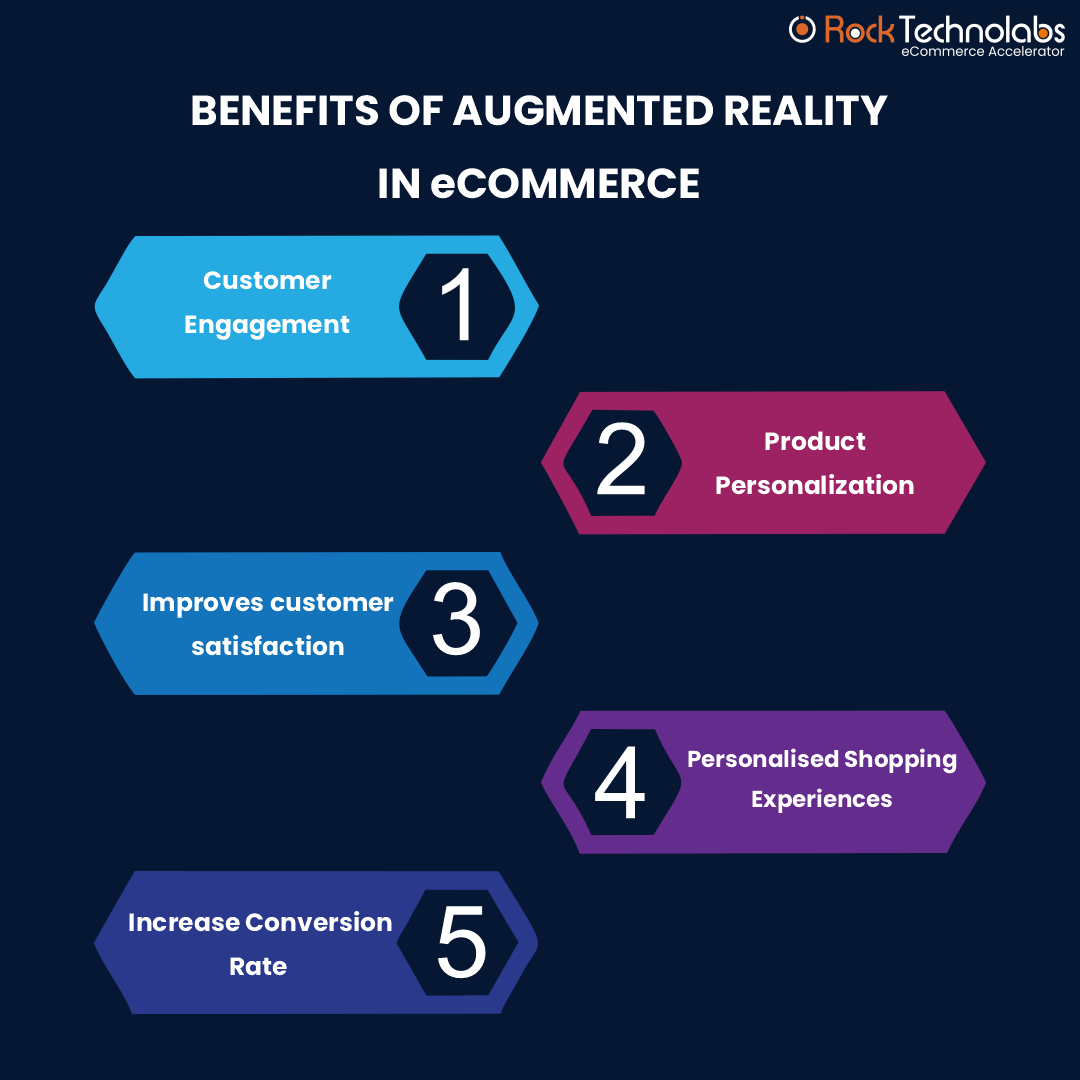Augmented Reality in e-commerce: How relevant it is in 2023?

As the coronavirus continues to spread over the globe and causes damage to the world economy. During the peak of the COVID-19 crisis, many countries across the globe introduced lockdown as preventive measures. As people have issued stay-at-home orders to reduce the spread of the disease, many of us are now self-isolating while turning to technology for work, education, communication, and shopping. From tourism to finance, the global pandemic has also influenced nearly every industry and sector.
According to Adobe Digital Economy Index, COVID-19 gave eCommerce an extra boost of $183 billion, as consumers flocked online to meet their daily needs. Hence it can be concluded that the eCommerce industry has seen a sudden spike due to COVID-19 pandemic, since consumers were confined to their home.
Read More: Impact of Covid-19 on eCommerce Businesses
Technology is the soul of the eCommerce industry and to support this statement a survey of Statista reveals that the market for AR technology is growing, with projections for 2023 valuing it at over $18 billion U.S. dollars. By 2022, customer spending on Augmented reality mobile applications worldwide is expected to reach $15.497 million. It is safe to say that Augmented Reality is the future of eCommerce websites.
This blog will help you understand Augmented Reality in e-commerce.
What is Augmented Reality?
Augmented Reality is a need of the hour. Augmented Reality is an alternative way of seeing the natural world using digital visual elements, sound, or other sensory stimuli delivered via technology. It is one of the most growing trends among eCommerce companies, including mobile computing and business applications.
Augmented Reality helps consumers to either “try” or examine a product by superimposing a digital image of a product over the front or rear-facing camera view.
It gives a view of understanding what you see in front of you when you physically visit a store.
This technology is indeed a game-changing shopping characteristic as they permit customers to sneak peek at that product in its proposed conditions. The superimposed sensory information can either be constructive or destructive, but the plan seamlessly combines the digital and physical worlds.
The eCommerce brands are already exploring AR, and AR technology can encourage them to stand out from the competition. It is being used to provide a more personalized experience to customers. Augmented Reality companies offer the customer an experience to examine products, the same as that to the in-person shopping experience but virtual.
What is Virtual Reality?
Virtual Reality is growing at a rapid speed. Virtual Reality produces a true-to-life practice. It is a computer-generated simulation of a three-dimensional image or domain associated with a seemingly natural or physical way by a person using special electronic equipment, such as a helmet with a screen inside or gloves fitted with sensors. Virtual Reality is known as computer-simulated Reality or immersive multimedia that creates completely immersive environments that make users feel like they have genuinely entered into simulated environments.
How Augmented Reality is Different from Virtual Reality?
Virtual Reality and Augmented Reality are the two main domains of prominent technologies. However, these terms are often confused and mixed and used conversely. Augmented Reality exhibits a computer-generated sensory in the real world. Augmented reality eCommerce enables you to make purchases on your mobile device or desktop. Augmented reality develops a virtual world that already exists and that you will still notice, upto some extent. On the other hand, Virtual reality engages you in a world of artificial creation.
Undoubtedly, Virtual Reality and Augmented Reality strive to accomplish two considerably different people in two very distinct ways, notwithstanding their devices’ similar purposes. VR is a replacement for augmented reality, and AR continues to reality, projecting knowledge on what you are already contemplating. These two are robust technologies that are yet to leave their mark on consumers. They can totally transform how computers are used in the future, but whether one or both will succeed is anyone’s guess right now.
How Businesses are using Augmented Reality?
Augmented-reality features are required for products where physical traits, such as size, are the primary factors propelling the purchase decision.
-
Virtual Try-On Experiences:
Augmented Reality technology offers Virtual Try-on experiences within your existing website, and product pages to allow customers to get a real sense of your products’ look, feel, and size.
You can check in the below image how Loreal is utilizing AR to assist their store visitors shop all the products online without being afraid of how it will look on them.

Image Source: Loreal
-
Enhanced Shopping Experiences:
Augmented Reality apps for home decor allow an excellent experience to the customers by delivering digitalized furniture objects directly into your room. In this way, you can check whether the furniture will fit in the room, match with the interior or not before making the purchase. IKEA is now offering open beta access to IKEA Studio , a new AR design app that allows users to customize entire rooms with IKEA brand furniture and decorations.

Image source – Ikea
Social Media Filters:
AR social media filters are computer-generated effects available across all the major social media platforms such as Facebook, Instagram, Snapchat, which you can overlay on pictures, GIFs, or videos and share with your social network. On the one hand, AR filters have started a new world of opportunities for several brands to promote their products.
The ability to preview the product in Augmented Reality takes away some of the uncertainty of shopping online. Several members commented that they felt more confident that they would not have to go through the hassle of returning their purchase.
Is Augmented Reality the Future of eCommerce?
Augmented Reality in eCommerce is intelligent, fun, helpful, and it’s the future that is never going to vanish but only grows. With the trend and demand to shop things at the comfort of the bed and eliminate the hassle of visiting and exploring the products, eCommerce has become a boon to the human population. Not only Augmented Reality is a powerful tool for driving customer engagement, but it also improves customer experiences in retail stores. Augmented Reality in online shopping is one of the best ways to provide customers assurance about the product buying and experiences where customers are required to provide more information about products.
How will Augmented Reality enhance the customer shopping experience in eCommerce websites?
AR provides e-commerce consumers with the screening of products or experience services and can check the product taking their own time before choosing to make a purchase. If you use Augmented Reality, your customers can be more inclined to select the correct product.
Online retailers are also beginning to use AR technology to reimagine the digital shopping experience with virtual stores. If you use a smartphone, consumers can move inside an AR dressing room, mix and match items, and make a purchase without ever leaving home comfort.
Augmented Reality reduces the gap between shopping at a physical location and online shopping by making it easier to represent merchandise and giving the consumer a better sense of what they are purchasing.
Augmented Reality can help online retailers significantly reduce returns by providing an engaging ‘try-before-you-buy digital experience. For example Puma, a sportswear brand, launched its first augmented reality store. These innovative AR solutions allow customers to visualize products in real-time from the comfort of their own homes.
Virtual makeup tools are handy, as choosing the best shade of a product demands matching it to the person’s skin tone in addition. Augmented Reality features that enabled users to see makeup products applied to their faces were perceived as very helpful by participants. These tools made them feel comfortable buying makeup online and helped them step outside their comfort zone and try a broader range of products than they might otherwise.
What is the Impact of Augmented Reality on the Retail Industry?
Augmented Reality offers extraordinary features of combining physical and virtual elements. Augmented Reality provides real-time access to consumers by customizing online shopping experience. This is done with social networking and mobile applications development and understanding consumer choices.
By leveraging Augmented Reality, retailers can create more touchpoints, allow hassle-free shopping, and provide customized loyalty programs. Hence, make the shopping experience feel different for the consumer. While many of us stayed inside four walls of home during a global pandemic, Augmented Reality helps transform our immediate surroundings into learning, work, and entertainment spaces.
Important Augmented Reality Statistics in eCommerce
- 1. 34% of customers already use AR applications while shopping.
- 2. Around 90 percent of companies with annual revenues of $100 million to $1 billion are now leveraging AR or VR technology. On the other hand, a poll conducted by a research firm revealed that 10 percent of ecommerce marketers utilize AR, and nearly 72% are planning to in the coming year.
- 3. According to a survey of Statista , by 2023 there will be an estimated 2.4 billion mobile augmented reality (AR) users worldwide, a rise of 2.2 billion from the 200 million seen in 2015.
- 4. 63% of customers say augmented reality would improve their shopping experience.
Five Benefits of Augmented Reality in E-Commerce
Augmented Reality is a technology that has happily combined digital information with real-life descriptions to interact with physical space, opening a new experience to a user. Augmented Reality benefits not only e-commerce brands but also customers. It establishes a strong collaboration that enriches the experience, sales, and brand visibility.
Here are five benefits of Augmented Reality in E-commerce.

-
1. Customer Engagement
Experiential marketing is the most valuable type of marketing but has always been the most difficult and cost-restrictive. Now, Augmented Reality is turning every type of marketing into experiential marketing. Brands that engage and interact with their customers have a much higher chance of success, and Augmented Reality is an automated way to do just that.
-
2. Product Personalization
Product Personalization adds a different charm to your product. It is a vital business element of online eCommerce websites. Most of the retail sector business offers customized tailor experience to their customers. Augmented Reality assists businesses in monetizing their personalization and lets customers try on products, as well as analyze. Hence, helps in making sound purchase decisions offering a personalized environment.
-
3. Improves Customer Satisfaction
Online eCommerce websites and brands have joined hands in improving customer’s shopping experience. The augmented reality technology grants customers who typically shop online to view the product in the form of a model they can interact with if they visited a physical store. It is a win-win financial situation for companies, as well as a win for their customer satisfaction.
-
4. Augmented Reality- a Standout Feature
Competition is a struggle that every online retailer encounters while embarking upon becoming an established online seller. Undoubtedly, Customers are spoiled by the choices and have options than they could ever possibly meet, and it can be challenging to find methods to make your brand stand out from the crowd. Augmented Reality makes online shopping an experience, which helps eCommerce businesses have an opportunity to set their brand isolate from the competition.
-
5. Increase Conversion Rate
For every business, it is essential to display their product to the customers. This will possibly work for eCommerce retailers with the maintenance of Augmented Reality. The customers who view the virtual product as a 2D image resemble it more closely. If customers adjust to perceive eCommerce’s complete view, they will be motivated to visit the shopping site more than once, and the conversion rate will eventually increase.
Also Read: Best Practices for Improving e-Commerce Checkout Flow
Final Words
Augmented Reality is still a new feature on the eCommerce landscape. Many renowned brands have already incorporated this technology to improve the customer’s shopping experience. Hence, it can be said that Augmented Reality technology is a must-have in eCommerce as it has its perks.
In today’s era of eCommerce, you must attempt to discover innovative methods to communicate with customers, and Augmented Reality in e-commerce gives you a competitive and creative edge. It is safe to say that social distancing has become the new normal seeing the current times, hence Augmented Reality is very much relevant in 2022 as it was before.
To learn more about the latest e-commerce trends and updates, keep watching this space. We have an exciting insightful eCommerce blog coming in the future.





